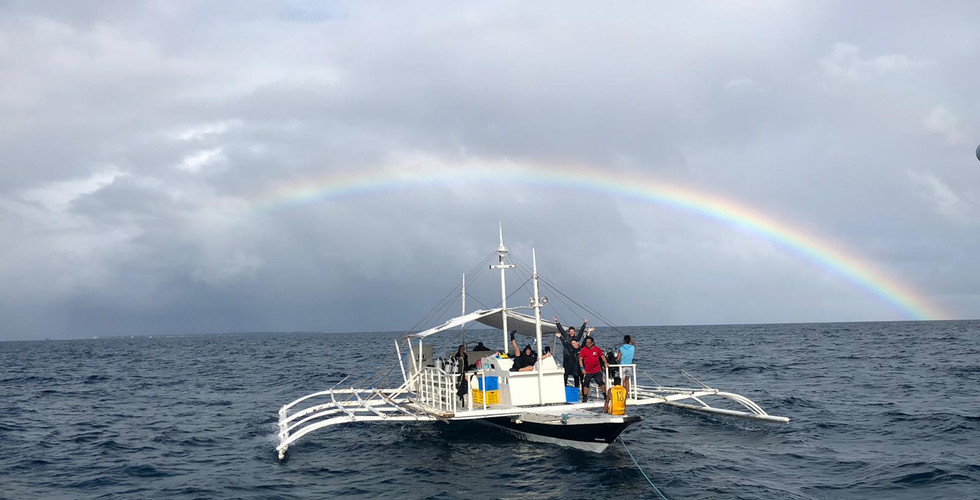A comment on the special relationship of the community of Malapascua Island and its thresher sharks, by Tom Sanborn, creator of Amigo sa mga Iho.

Everyone comes here for the sharks. It’s the first thing you notice when the boat arrives at Bounty Beach on Malapascua Island. The gleaming white sands march up the shore until they meet a row of dive shops, resorts, and restaurants that cater to the waves of seasonal tourists, each one eager for the chance to get in the water with the enigmatic thresher sharks. These sharks put the island on the map thanks to something unique just off the island’s coast. Eight kilometres east of Malapascua lies Monad Shoal, a sea mount rising from the ocean floor with a bustling ecology of cleaner fish nestled along its slopes. Their clients range from tiny, darting damsel fish to silently gliding manta rays and the service the cleaner fish provide by removing parasites from their skin and gills is often crucial to these animal’s health. Yet, despite this flourishing diversity, it is the cleaner’s thresher shark clientele that continues to draw international attention. Monad Shoal is the only known place in the world where these normally elusive open water sharks can consistently be found year round, and that phenomenon is enough to make hundreds of divers rise daily at 4 am to make the trip to Monad Shoal and see the sharks as they arrive each morning to be cleaned.

This was the face of Malapascua that I remembered from years ago, one characterised by fine sand beaches, shoreline restaurants calling out promises of cold beer and fresh caught fish, and the bleary-eyed early morning rush to beat the sun to the dive sites. I was fortunate to be able to visit this place then as a tourist, long before I joined the Cyan Planet family. However, my return to this place was very different. In December, I was given the opportunity to assist the Thresher Shark Research and Conservation Project while conducting a research project of my own. The Thresher Shark Research and Conservation Project is a locally based organisation that has been operating in Malapascua since 2015. Since its inception, the organisation has taken an active role in advocating for the threshers by not only generating valuable research but using that information to help inform the community as the shark’s fame grew. With that fame came a swell of tourism and the island was faced with the difficult task of ensuring that the sharks weren’t swallowed by that wave.
The threshers undeniably built Malapascua into what it is today. The money the sharks brought in reinvigorated the small island’s economy and incomes shifted from primarily fishing to the more lucrative ecotourism industry. That fundamental change in the relationship to the sharks also changed the attitude. Where Malapascua’s fishermen traditionally hunted the thresher sharks for their fins, those old traditions blossomed into a new passion for protecting them. Since the sharks became tied to livelihoods, conserving them became an integral part of the island’s way of life. Organisations like the Thresher Shark Research and Conservation Project have been crucial in providing guidance as Malapascua now survives with the sharks. When Typhoon Haiyan raged across the Pacific in 2013 and decimated the island, it was income from the threshers that allowed them to rebuild. It is helping them to recover again after Typhoon Phanfone smashed their boats and tore pieces from their homes last December. Malapascua’s future is intertwined with how sustainably their relationship with the sharks grows.

This relationship is what makes this island so special. The restaurants, dive resorts, and glittering lights reflecting across white beaches are not the full face of Malapascua; I’ve found these things in a thousand other places. Living here now, what stands out is the community behind these things, a community built on the idea that economic growth and environmental stewardship do not need to be exclusive. I believe in people and I believe in the power of communities to find solutions that grow not only from the needs of nature, but from the needs of the people who depend upon it. So far, Malapascua has been a success story thanks to the efforts of passionate advocates within its communities and to organisations like the Thresher Shark Research and Conservation Project. I am proud to count myself among them as an “amigo sa mga iho”, a friend to the sharks.
Photo credits: Kammonat Oat, Adam Joshua Lee, Tom Sanborn








Opmerkingen